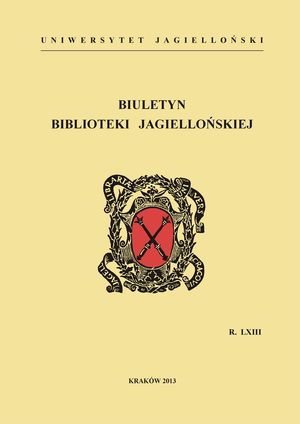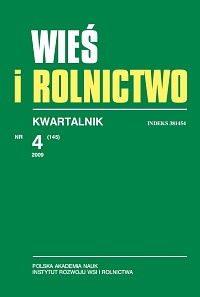Zmiany zatrudnienia i źródeł utrzymania ludności w gospodarstwach rolnych w latach 2005-2007
Author(s): Izasław Frenkel / Language(s): Polish
/ Issue: 4/2009
Keywords: employment; incomes; age; sex; education;
zatrudnienie; dochody; wiek; płeć; wykształcenie
The article presents the results of an analysis of changes in the employment and sources of incomes of the population of private farms in light of the data of representative surveys of the structure of agricultural farms conducted by the Central Statistical Office (GUS) in 2005 and 2007. The employment analysis was focussed on changes in the number of working persons among the farms’ population, examined in accordance with its division into the group of persons working exclusively, chiefly and additionally on a farm, and on changes in the demographic and educational structure of each of these groups. The analysis of incomes was focussed on changes in the structure of households assessed from the point of view of the main sources of income such as income from agricultural activity, income earned through work done under contract, income from non-agricultural economic activity and non-earned income, including old age and disability pensions. Changes in both employment and incomes were analysed in accordance with the division of farms into acreage groups. The assessment of the revealed tendencies permits to state that the direction of the analysed changes was generally desirable: the overall number of persons working on farms diminished, the proportion of persons working outside agriculture and having incomes from such work increased, the educational level of the farms’ users improved. The main factors of the recorded changes were: a decline in the number of farms and an improvement in their acreage structure, a rise in the demand for labour outside agriculture and the development of education at secondary and higher levels.
W artykule przedstawiono wyniki analizy zmian zatrudnienia i źródeł utrzymania ludności w indywidualnych gospodarstwach rolnych w świetle danych reprezentacyjnych badań struktury gospodarstw rolnych przeprowadzonych przez GUS w latach 2005 i 2007. Przedmiotem analizy zatrudnienia były w szczególności zmiany liczby pracujących w gospodarstwach rolnych w podziale na pracujących wyłącznie, głównie i dodatkowo w gospodarstwie oraz struktury każdej z tych populacji według cech demograficznych i poziomu wykształcenia. W odniesieniu do dochodów skoncentrowano się na analizie zmian w strukturze gospodarstw domowych według głównego źródła dochodów, wyodrębniając m.in. dochody z działalności rolniczej, pracy najemnej, pozarolniczej działalności gospodarczej i źródeł niezarobkowych, w tym emerytur i rent. Zarówno zmiany zatrudnienia, jak i dochodów analizowane były w zróżnicowaniu według grup obszarowych gospodarstw rolnych. Oceniając w konkluzji przedstawione tendencje zmian, uznano, że na ogół zmierzały one w pożądanym kierunku: zmniejszyła się ogólna liczba pracujących w gospodarstwie, zwiększył się odsetek pracujących poza gospodarstwem i odsetek gospodarstw uzyskujących dochody z tej pracy, wzrósł poziom wykształcenia użytkowników gospodarstw. Podstawą tych zmian było głównie zmniejszenie się liczby gospodarstw i poprawa ich struktury
More...


